Human Resource Management Analysis and Recommendations for Air Malta
VerifiedAdded on 2022/11/25
|20
|5328
|242
Report
AI Summary
This report provides a comprehensive analysis of Air Malta's human resource management (HRM) practices. It begins with an overview of the HRM approaches employed by Air Malta, identifying both strategic and reactive elements, and explores the company's employee-oriented approach. The report then applies the Harvard HRM model to assess Air Malta's practices, highlighting the importance of aligning HRM strategies with business objectives and considering all stakeholder interests. A detailed analysis of Air Malta's recruitment and selection processes follows, examining the use of employer branding, internal recruitment, and job boards, while also pointing out limitations such as a restricted talent pool. The report then delves into Air Malta's approach to human resource development, and proposes a hybrid theory of motivation. Finally, it identifies key characteristics of effective leaders to enhance Air Malta's long-term viability, concluding with recommendations for improvement, such as outsourcing the entire training process. The report emphasizes the need for cost-effectiveness, strategic alignment, and a broader approach to recruitment to enhance the airline's competitiveness and profitability.
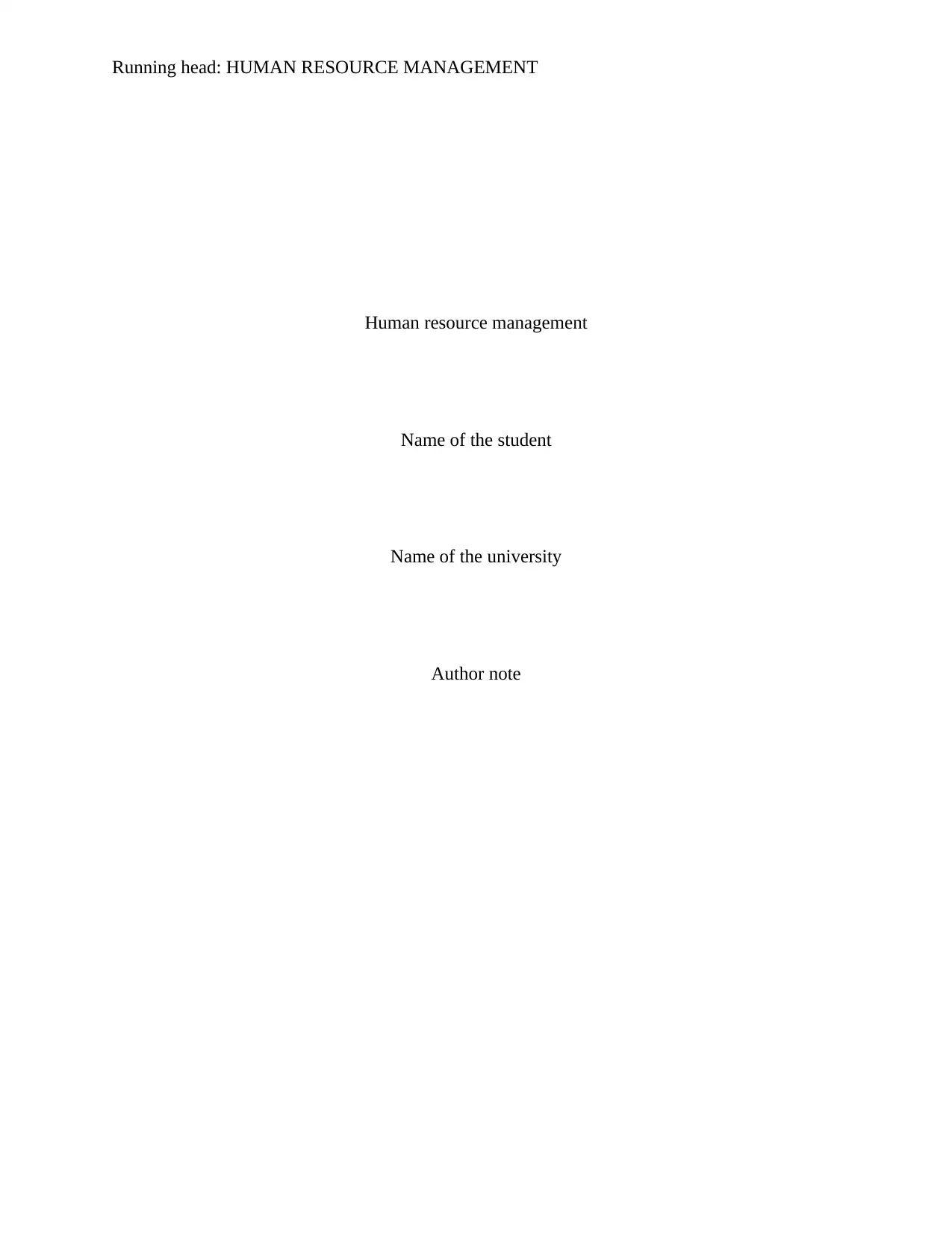
Running head: HUMAN RESOURCE MANAGEMENT
Human resource management
Name of the student
Name of the university
Author note
Human resource management
Name of the student
Name of the university
Author note
Paraphrase This Document
Need a fresh take? Get an instant paraphrase of this document with our AI Paraphraser
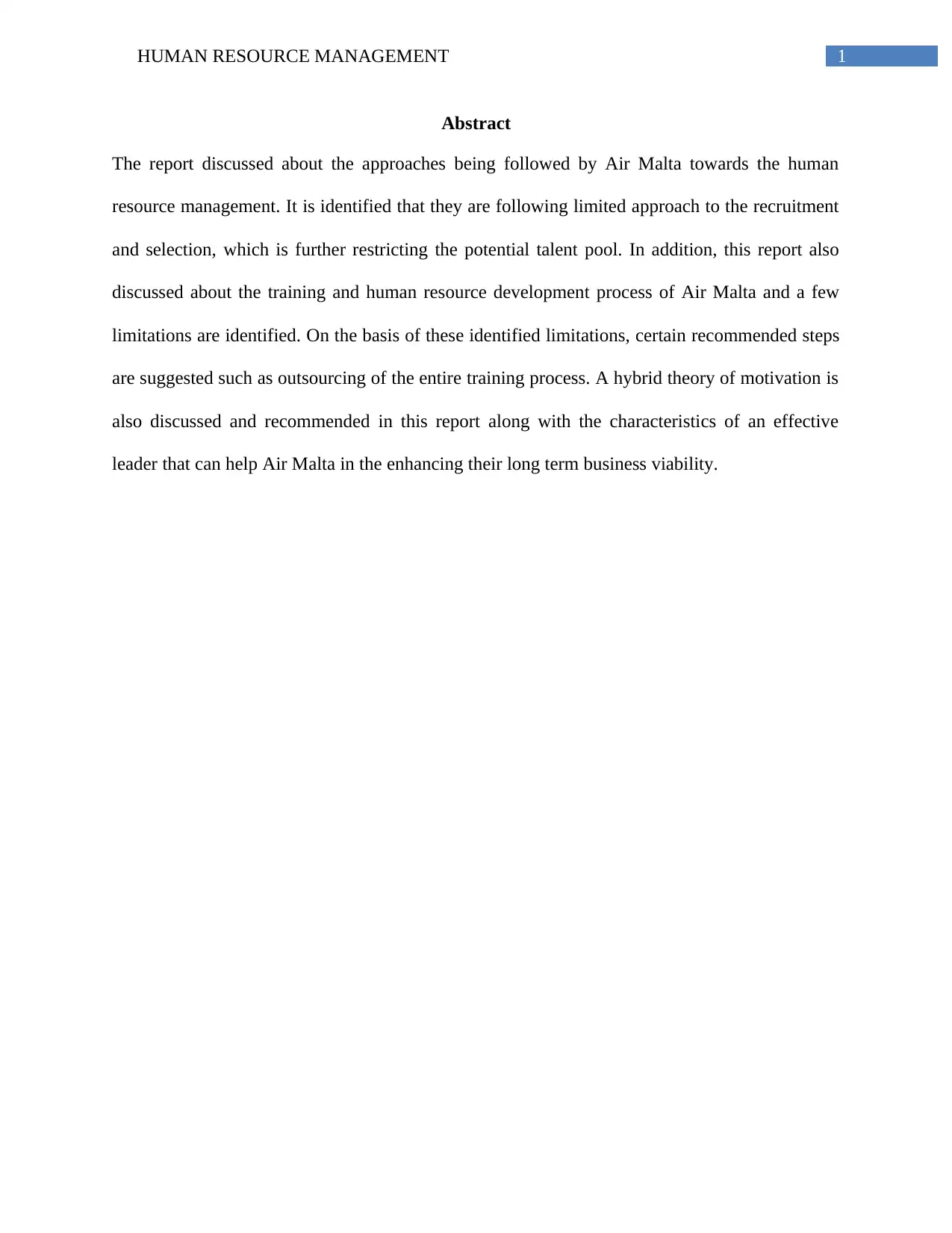
1HUMAN RESOURCE MANAGEMENT
Abstract
The report discussed about the approaches being followed by Air Malta towards the human
resource management. It is identified that they are following limited approach to the recruitment
and selection, which is further restricting the potential talent pool. In addition, this report also
discussed about the training and human resource development process of Air Malta and a few
limitations are identified. On the basis of these identified limitations, certain recommended steps
are suggested such as outsourcing of the entire training process. A hybrid theory of motivation is
also discussed and recommended in this report along with the characteristics of an effective
leader that can help Air Malta in the enhancing their long term business viability.
Abstract
The report discussed about the approaches being followed by Air Malta towards the human
resource management. It is identified that they are following limited approach to the recruitment
and selection, which is further restricting the potential talent pool. In addition, this report also
discussed about the training and human resource development process of Air Malta and a few
limitations are identified. On the basis of these identified limitations, certain recommended steps
are suggested such as outsourcing of the entire training process. A hybrid theory of motivation is
also discussed and recommended in this report along with the characteristics of an effective
leader that can help Air Malta in the enhancing their long term business viability.
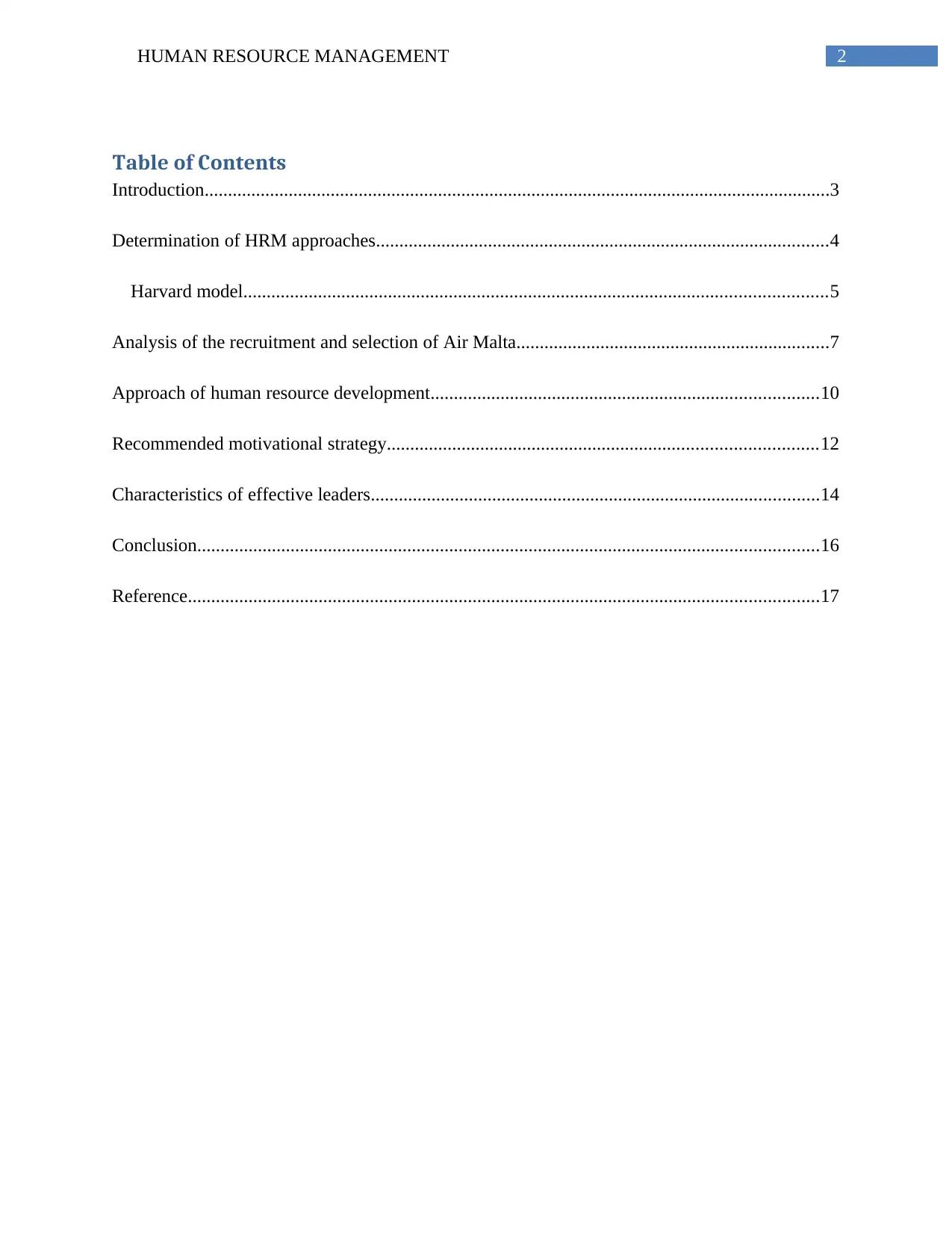
2HUMAN RESOURCE MANAGEMENT
Table of Contents
Introduction......................................................................................................................................3
Determination of HRM approaches.................................................................................................4
Harvard model.............................................................................................................................5
Analysis of the recruitment and selection of Air Malta...................................................................7
Approach of human resource development...................................................................................10
Recommended motivational strategy............................................................................................12
Characteristics of effective leaders................................................................................................14
Conclusion.....................................................................................................................................16
Reference.......................................................................................................................................17
Table of Contents
Introduction......................................................................................................................................3
Determination of HRM approaches.................................................................................................4
Harvard model.............................................................................................................................5
Analysis of the recruitment and selection of Air Malta...................................................................7
Approach of human resource development...................................................................................10
Recommended motivational strategy............................................................................................12
Characteristics of effective leaders................................................................................................14
Conclusion.....................................................................................................................................16
Reference.......................................................................................................................................17
⊘ This is a preview!⊘
Do you want full access?
Subscribe today to unlock all pages.

Trusted by 1+ million students worldwide

3HUMAN RESOURCE MANAGEMENT
Introduction
Effectiveness of the human resource management is important in gaining competitive
advantages for the contemporary business organizations. This is due to the reason that
effectiveness of the employee management will determine the extent to which the internal
performance and productivity is meeting the desired outcome. However, on the other hand, it
should also be noted that employee management process should be restructured with time and
according to the change in the external situations. This will ensure the maximum utility of the
employee management strategy in coping up with the changes in the external factors. Different
companies are having different sets of human resource management strategies based on their
existing situations.
Air Malta is the leading and flag carrier of Malta and operating from the Malta
International Airport. Currently they are providing services to Europe, Middle Eastern regions
and North Africa. However, compared to other leading flag carriers in the world, Air Malta is
having small scale business operations with having the fleet size of 10 aircrafts. This is in
accordance to their limited operations (airmalta.com 2019). However, the major challenge for
them is managing the profits and for the first time, they have made profits in 2018 since their
inception. In this case, their internal process and practices should be restructured to reduce the
cost of operation and increase the effectiveness.
This report will discuss about the current human resource management processes of Air
Malta and how they can be improved. In addition, their approach of employee management will
also be analyzed on the basis of different models and theories. The recruitment and selection
process of Air Malta will also be analyzed and recommendations will be made. Based on the
Introduction
Effectiveness of the human resource management is important in gaining competitive
advantages for the contemporary business organizations. This is due to the reason that
effectiveness of the employee management will determine the extent to which the internal
performance and productivity is meeting the desired outcome. However, on the other hand, it
should also be noted that employee management process should be restructured with time and
according to the change in the external situations. This will ensure the maximum utility of the
employee management strategy in coping up with the changes in the external factors. Different
companies are having different sets of human resource management strategies based on their
existing situations.
Air Malta is the leading and flag carrier of Malta and operating from the Malta
International Airport. Currently they are providing services to Europe, Middle Eastern regions
and North Africa. However, compared to other leading flag carriers in the world, Air Malta is
having small scale business operations with having the fleet size of 10 aircrafts. This is in
accordance to their limited operations (airmalta.com 2019). However, the major challenge for
them is managing the profits and for the first time, they have made profits in 2018 since their
inception. In this case, their internal process and practices should be restructured to reduce the
cost of operation and increase the effectiveness.
This report will discuss about the current human resource management processes of Air
Malta and how they can be improved. In addition, their approach of employee management will
also be analyzed on the basis of different models and theories. The recruitment and selection
process of Air Malta will also be analyzed and recommendations will be made. Based on the
Paraphrase This Document
Need a fresh take? Get an instant paraphrase of this document with our AI Paraphraser
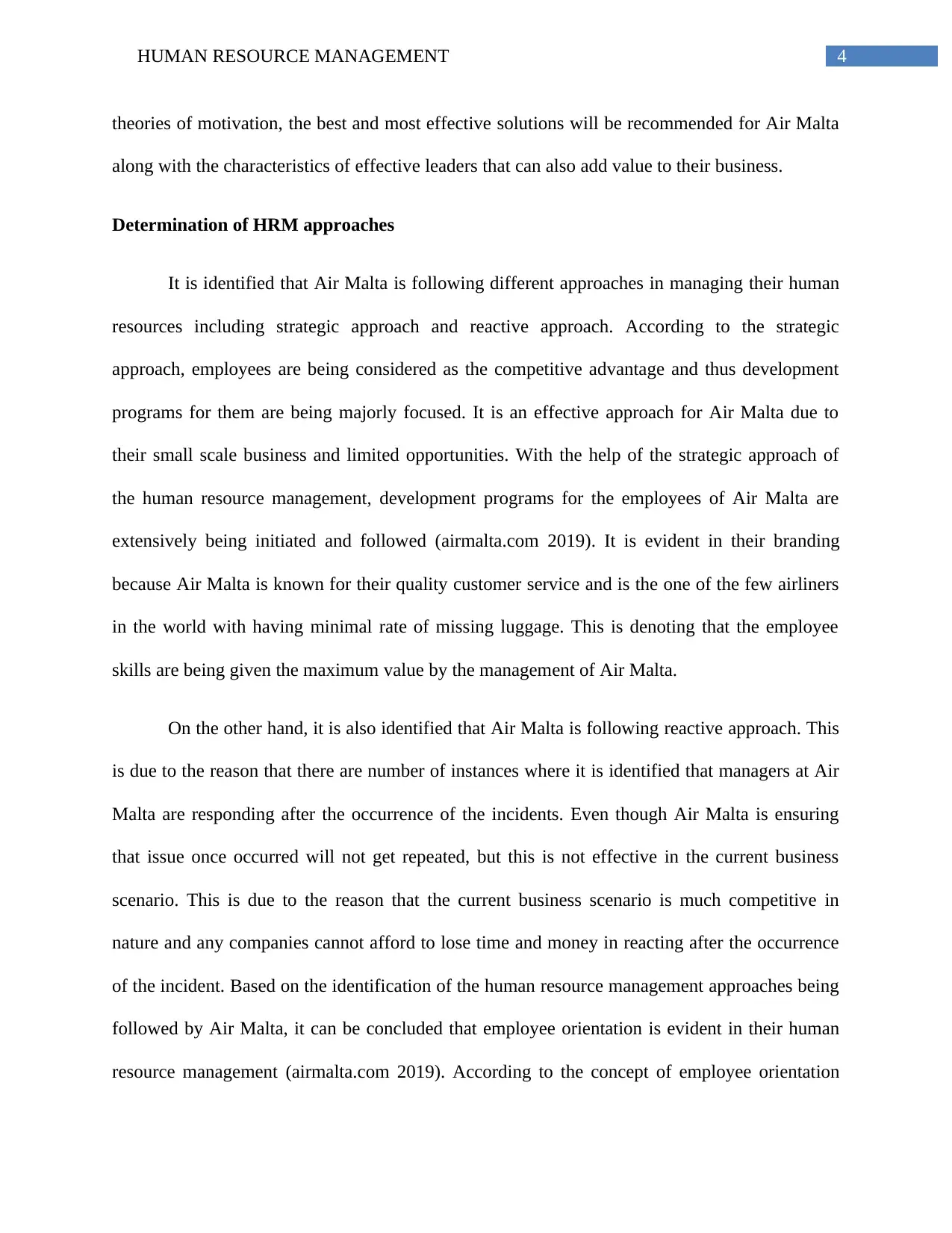
4HUMAN RESOURCE MANAGEMENT
theories of motivation, the best and most effective solutions will be recommended for Air Malta
along with the characteristics of effective leaders that can also add value to their business.
Determination of HRM approaches
It is identified that Air Malta is following different approaches in managing their human
resources including strategic approach and reactive approach. According to the strategic
approach, employees are being considered as the competitive advantage and thus development
programs for them are being majorly focused. It is an effective approach for Air Malta due to
their small scale business and limited opportunities. With the help of the strategic approach of
the human resource management, development programs for the employees of Air Malta are
extensively being initiated and followed (airmalta.com 2019). It is evident in their branding
because Air Malta is known for their quality customer service and is the one of the few airliners
in the world with having minimal rate of missing luggage. This is denoting that the employee
skills are being given the maximum value by the management of Air Malta.
On the other hand, it is also identified that Air Malta is following reactive approach. This
is due to the reason that there are number of instances where it is identified that managers at Air
Malta are responding after the occurrence of the incidents. Even though Air Malta is ensuring
that issue once occurred will not get repeated, but this is not effective in the current business
scenario. This is due to the reason that the current business scenario is much competitive in
nature and any companies cannot afford to lose time and money in reacting after the occurrence
of the incident. Based on the identification of the human resource management approaches being
followed by Air Malta, it can be concluded that employee orientation is evident in their human
resource management (airmalta.com 2019). According to the concept of employee orientation
theories of motivation, the best and most effective solutions will be recommended for Air Malta
along with the characteristics of effective leaders that can also add value to their business.
Determination of HRM approaches
It is identified that Air Malta is following different approaches in managing their human
resources including strategic approach and reactive approach. According to the strategic
approach, employees are being considered as the competitive advantage and thus development
programs for them are being majorly focused. It is an effective approach for Air Malta due to
their small scale business and limited opportunities. With the help of the strategic approach of
the human resource management, development programs for the employees of Air Malta are
extensively being initiated and followed (airmalta.com 2019). It is evident in their branding
because Air Malta is known for their quality customer service and is the one of the few airliners
in the world with having minimal rate of missing luggage. This is denoting that the employee
skills are being given the maximum value by the management of Air Malta.
On the other hand, it is also identified that Air Malta is following reactive approach. This
is due to the reason that there are number of instances where it is identified that managers at Air
Malta are responding after the occurrence of the incidents. Even though Air Malta is ensuring
that issue once occurred will not get repeated, but this is not effective in the current business
scenario. This is due to the reason that the current business scenario is much competitive in
nature and any companies cannot afford to lose time and money in reacting after the occurrence
of the incident. Based on the identification of the human resource management approaches being
followed by Air Malta, it can be concluded that employee orientation is evident in their human
resource management (airmalta.com 2019). According to the concept of employee orientation
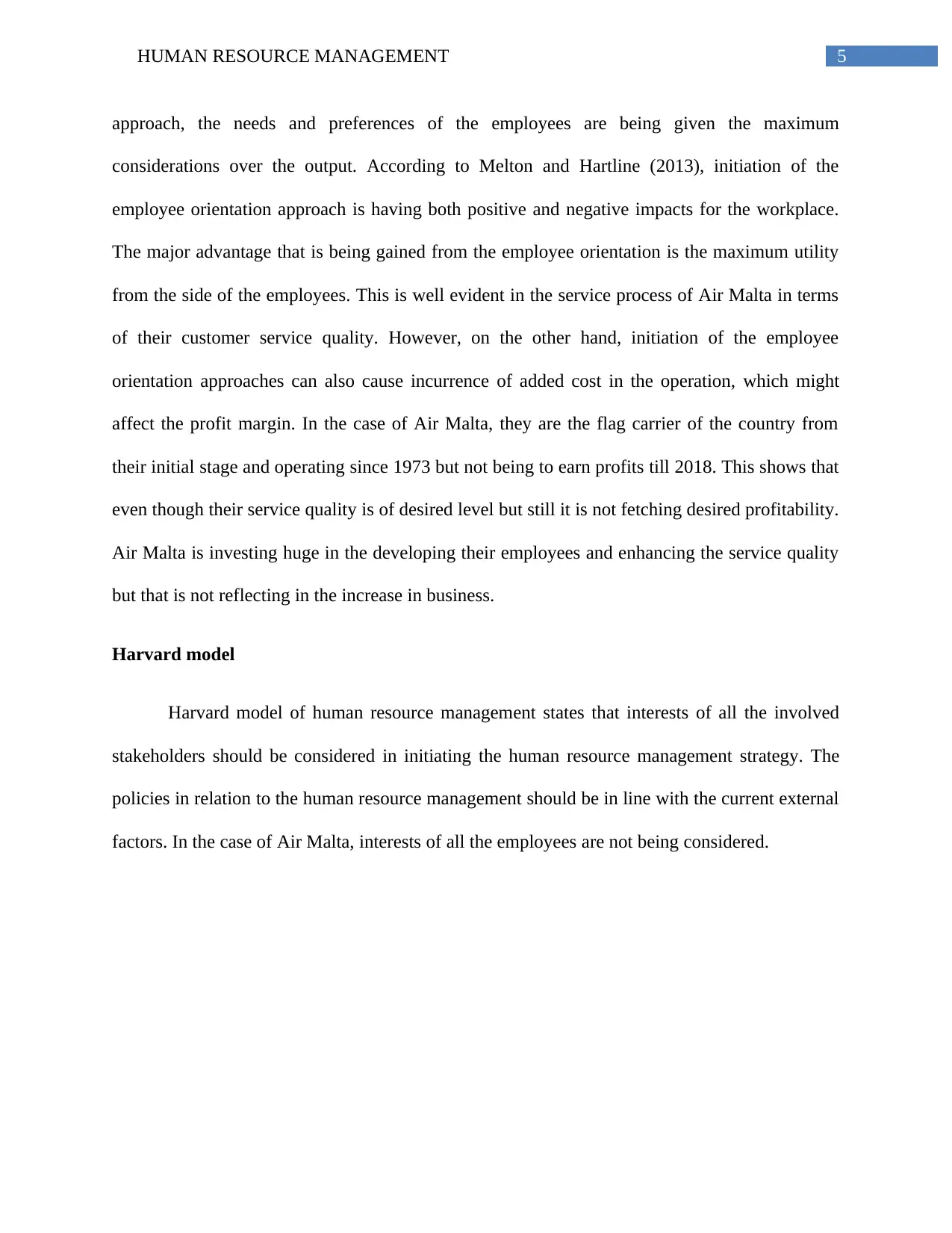
5HUMAN RESOURCE MANAGEMENT
approach, the needs and preferences of the employees are being given the maximum
considerations over the output. According to Melton and Hartline (2013), initiation of the
employee orientation approach is having both positive and negative impacts for the workplace.
The major advantage that is being gained from the employee orientation is the maximum utility
from the side of the employees. This is well evident in the service process of Air Malta in terms
of their customer service quality. However, on the other hand, initiation of the employee
orientation approaches can also cause incurrence of added cost in the operation, which might
affect the profit margin. In the case of Air Malta, they are the flag carrier of the country from
their initial stage and operating since 1973 but not being to earn profits till 2018. This shows that
even though their service quality is of desired level but still it is not fetching desired profitability.
Air Malta is investing huge in the developing their employees and enhancing the service quality
but that is not reflecting in the increase in business.
Harvard model
Harvard model of human resource management states that interests of all the involved
stakeholders should be considered in initiating the human resource management strategy. The
policies in relation to the human resource management should be in line with the current external
factors. In the case of Air Malta, interests of all the employees are not being considered.
approach, the needs and preferences of the employees are being given the maximum
considerations over the output. According to Melton and Hartline (2013), initiation of the
employee orientation approach is having both positive and negative impacts for the workplace.
The major advantage that is being gained from the employee orientation is the maximum utility
from the side of the employees. This is well evident in the service process of Air Malta in terms
of their customer service quality. However, on the other hand, initiation of the employee
orientation approaches can also cause incurrence of added cost in the operation, which might
affect the profit margin. In the case of Air Malta, they are the flag carrier of the country from
their initial stage and operating since 1973 but not being to earn profits till 2018. This shows that
even though their service quality is of desired level but still it is not fetching desired profitability.
Air Malta is investing huge in the developing their employees and enhancing the service quality
but that is not reflecting in the increase in business.
Harvard model
Harvard model of human resource management states that interests of all the involved
stakeholders should be considered in initiating the human resource management strategy. The
policies in relation to the human resource management should be in line with the current external
factors. In the case of Air Malta, interests of all the employees are not being considered.
⊘ This is a preview!⊘
Do you want full access?
Subscribe today to unlock all pages.

Trusted by 1+ million students worldwide
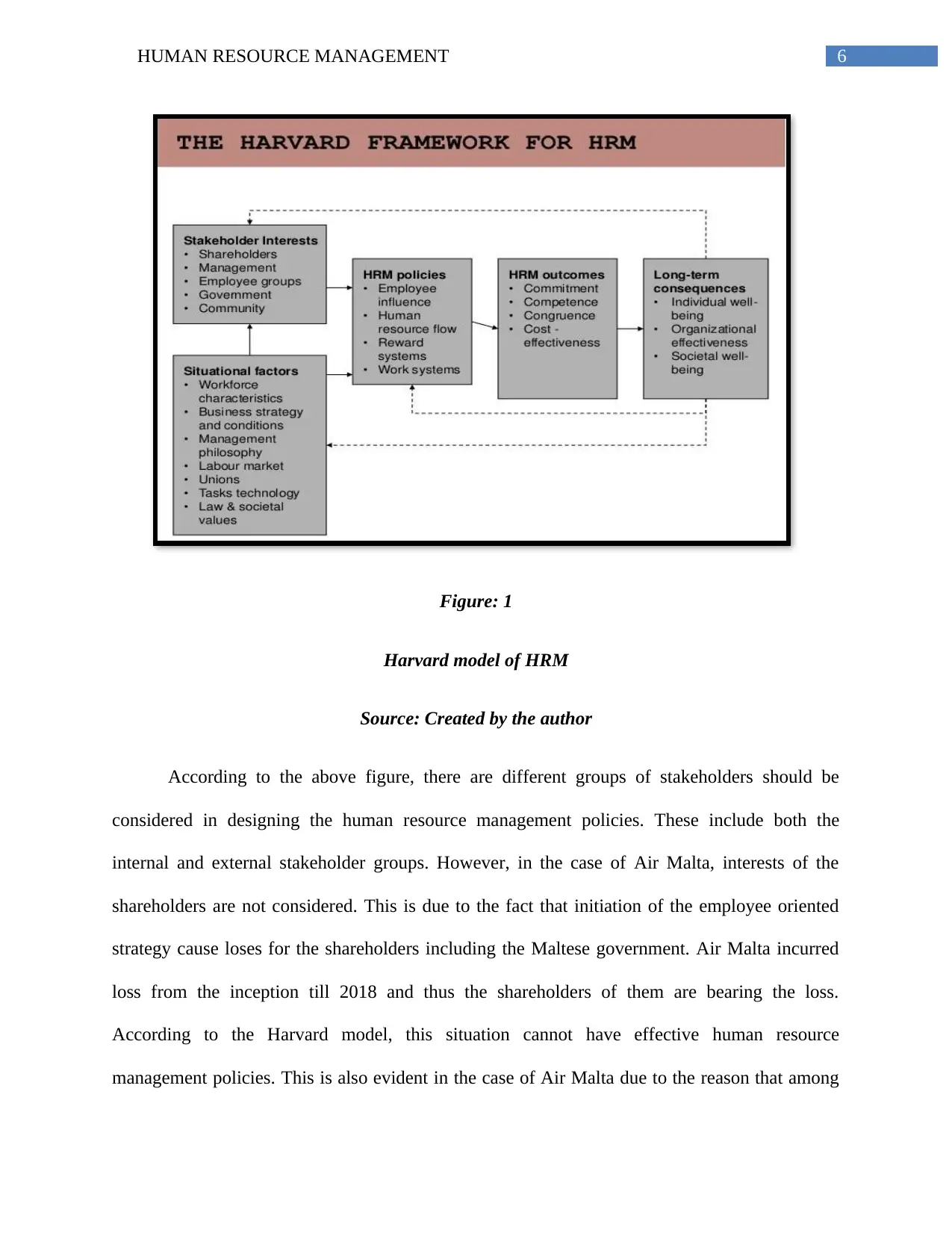
6HUMAN RESOURCE MANAGEMENT
Figure: 1
Harvard model of HRM
Source: Created by the author
According to the above figure, there are different groups of stakeholders should be
considered in designing the human resource management policies. These include both the
internal and external stakeholder groups. However, in the case of Air Malta, interests of the
shareholders are not considered. This is due to the fact that initiation of the employee oriented
strategy cause loses for the shareholders including the Maltese government. Air Malta incurred
loss from the inception till 2018 and thus the shareholders of them are bearing the loss.
According to the Harvard model, this situation cannot have effective human resource
management policies. This is also evident in the case of Air Malta due to the reason that among
Figure: 1
Harvard model of HRM
Source: Created by the author
According to the above figure, there are different groups of stakeholders should be
considered in designing the human resource management policies. These include both the
internal and external stakeholder groups. However, in the case of Air Malta, interests of the
shareholders are not considered. This is due to the fact that initiation of the employee oriented
strategy cause loses for the shareholders including the Maltese government. Air Malta incurred
loss from the inception till 2018 and thus the shareholders of them are bearing the loss.
According to the Harvard model, this situation cannot have effective human resource
management policies. This is also evident in the case of Air Malta due to the reason that among
Paraphrase This Document
Need a fresh take? Get an instant paraphrase of this document with our AI Paraphraser
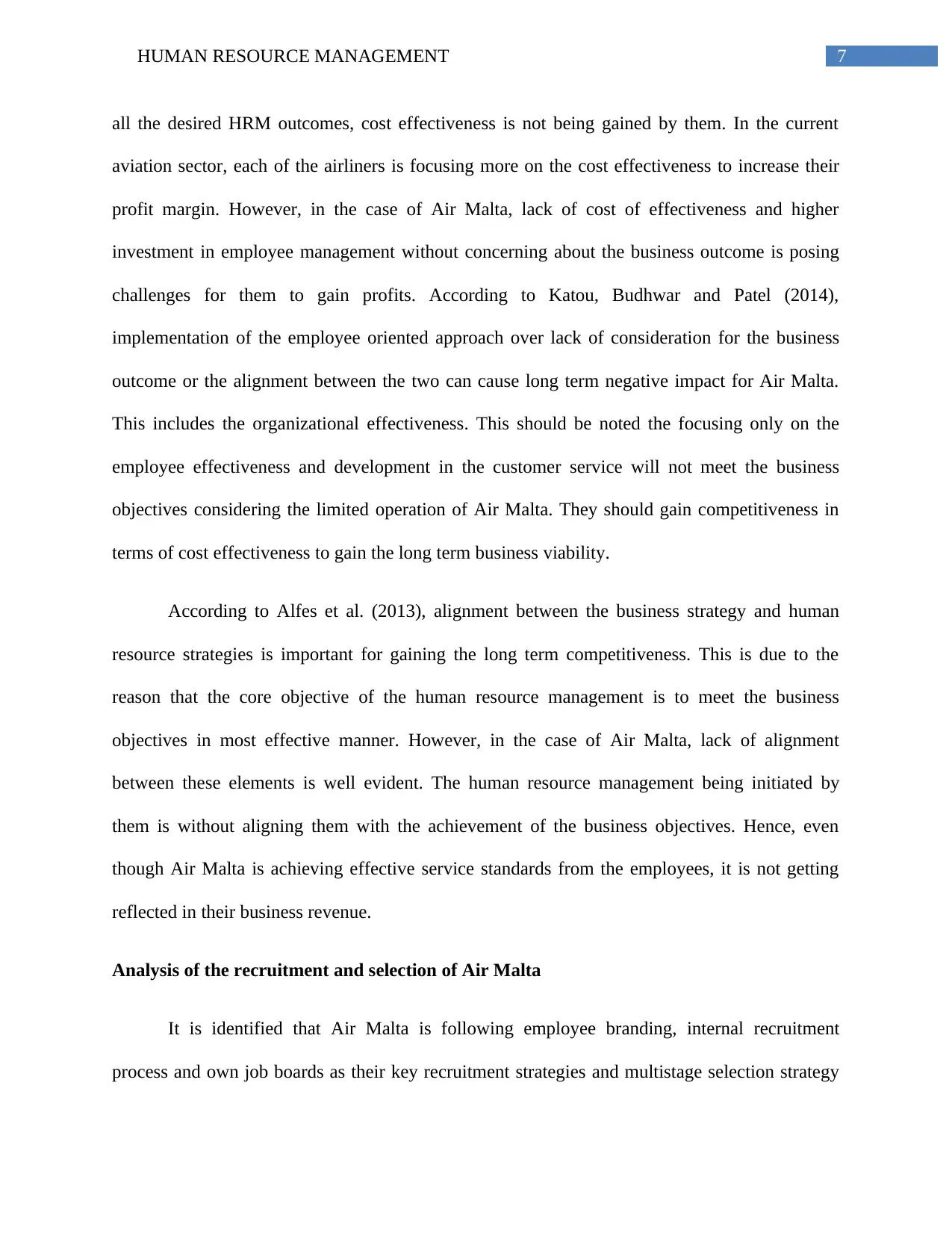
7HUMAN RESOURCE MANAGEMENT
all the desired HRM outcomes, cost effectiveness is not being gained by them. In the current
aviation sector, each of the airliners is focusing more on the cost effectiveness to increase their
profit margin. However, in the case of Air Malta, lack of cost of effectiveness and higher
investment in employee management without concerning about the business outcome is posing
challenges for them to gain profits. According to Katou, Budhwar and Patel (2014),
implementation of the employee oriented approach over lack of consideration for the business
outcome or the alignment between the two can cause long term negative impact for Air Malta.
This includes the organizational effectiveness. This should be noted the focusing only on the
employee effectiveness and development in the customer service will not meet the business
objectives considering the limited operation of Air Malta. They should gain competitiveness in
terms of cost effectiveness to gain the long term business viability.
According to Alfes et al. (2013), alignment between the business strategy and human
resource strategies is important for gaining the long term competitiveness. This is due to the
reason that the core objective of the human resource management is to meet the business
objectives in most effective manner. However, in the case of Air Malta, lack of alignment
between these elements is well evident. The human resource management being initiated by
them is without aligning them with the achievement of the business objectives. Hence, even
though Air Malta is achieving effective service standards from the employees, it is not getting
reflected in their business revenue.
Analysis of the recruitment and selection of Air Malta
It is identified that Air Malta is following employee branding, internal recruitment
process and own job boards as their key recruitment strategies and multistage selection strategy
all the desired HRM outcomes, cost effectiveness is not being gained by them. In the current
aviation sector, each of the airliners is focusing more on the cost effectiveness to increase their
profit margin. However, in the case of Air Malta, lack of cost of effectiveness and higher
investment in employee management without concerning about the business outcome is posing
challenges for them to gain profits. According to Katou, Budhwar and Patel (2014),
implementation of the employee oriented approach over lack of consideration for the business
outcome or the alignment between the two can cause long term negative impact for Air Malta.
This includes the organizational effectiveness. This should be noted the focusing only on the
employee effectiveness and development in the customer service will not meet the business
objectives considering the limited operation of Air Malta. They should gain competitiveness in
terms of cost effectiveness to gain the long term business viability.
According to Alfes et al. (2013), alignment between the business strategy and human
resource strategies is important for gaining the long term competitiveness. This is due to the
reason that the core objective of the human resource management is to meet the business
objectives in most effective manner. However, in the case of Air Malta, lack of alignment
between these elements is well evident. The human resource management being initiated by
them is without aligning them with the achievement of the business objectives. Hence, even
though Air Malta is achieving effective service standards from the employees, it is not getting
reflected in their business revenue.
Analysis of the recruitment and selection of Air Malta
It is identified that Air Malta is following employee branding, internal recruitment
process and own job boards as their key recruitment strategies and multistage selection strategy

8HUMAN RESOURCE MANAGEMENT
as part of the selection of the new employees. On the basis of the positive word of mouth and
market branding, Air Malta is leveraging in their brand name for attracting new employees. This
is due to the reason that in the current scenario, new candidates are getting more attracted
towards the ethical companies and Air Malta is leveraging on this trend. According to Leekha
Chhabra and Sharma (2014), leveraging on the employer branding is helping Air Malta in getting
the candidates who are already aware about the business processes. The candidates who are
getting attracted on the basis of the employer branding of Air Malta, are already having the basic
understanding about how the job is done there. Hence, it is beneficial for the managers of Air
Malta in selecting the potential candidates. Furthermore, internal recruitment process by means
of references from the existing employees is also being followed by Air Malta. This strategy is
also helping them in getting the potential employees who are already aware about the process
and practices of the organization. In the case of internal recruitment process, the existing
employees refer the most eligible one and the first round of screening gets done by this.
According to Ommeren and Russo (2014), the major advantage of internal recruitment
process is the less cost involved. There are no extra cost involved in searching for the potential
candidates and no need of job advertisements. Hence, cost effectiveness can be gained by
implementing this strategy. On the other hand, it is stated by Shammot (2014) that with the help
of the internal recruitment process, retention rate of the staffs gets increased. This is due to the
reason that involvement of the existing employees in the recruitment process will increase the
sense of importance among them. Thus, the employee engagement process will also get effective
with this. Air Malta is also having separate and dedicated section for career in their official
website. Potential candidates can apply to the suitable job profiles advertised in this section.
as part of the selection of the new employees. On the basis of the positive word of mouth and
market branding, Air Malta is leveraging in their brand name for attracting new employees. This
is due to the reason that in the current scenario, new candidates are getting more attracted
towards the ethical companies and Air Malta is leveraging on this trend. According to Leekha
Chhabra and Sharma (2014), leveraging on the employer branding is helping Air Malta in getting
the candidates who are already aware about the business processes. The candidates who are
getting attracted on the basis of the employer branding of Air Malta, are already having the basic
understanding about how the job is done there. Hence, it is beneficial for the managers of Air
Malta in selecting the potential candidates. Furthermore, internal recruitment process by means
of references from the existing employees is also being followed by Air Malta. This strategy is
also helping them in getting the potential employees who are already aware about the process
and practices of the organization. In the case of internal recruitment process, the existing
employees refer the most eligible one and the first round of screening gets done by this.
According to Ommeren and Russo (2014), the major advantage of internal recruitment
process is the less cost involved. There are no extra cost involved in searching for the potential
candidates and no need of job advertisements. Hence, cost effectiveness can be gained by
implementing this strategy. On the other hand, it is stated by Shammot (2014) that with the help
of the internal recruitment process, retention rate of the staffs gets increased. This is due to the
reason that involvement of the existing employees in the recruitment process will increase the
sense of importance among them. Thus, the employee engagement process will also get effective
with this. Air Malta is also having separate and dedicated section for career in their official
website. Potential candidates can apply to the suitable job profiles advertised in this section.
⊘ This is a preview!⊘
Do you want full access?
Subscribe today to unlock all pages.

Trusted by 1+ million students worldwide
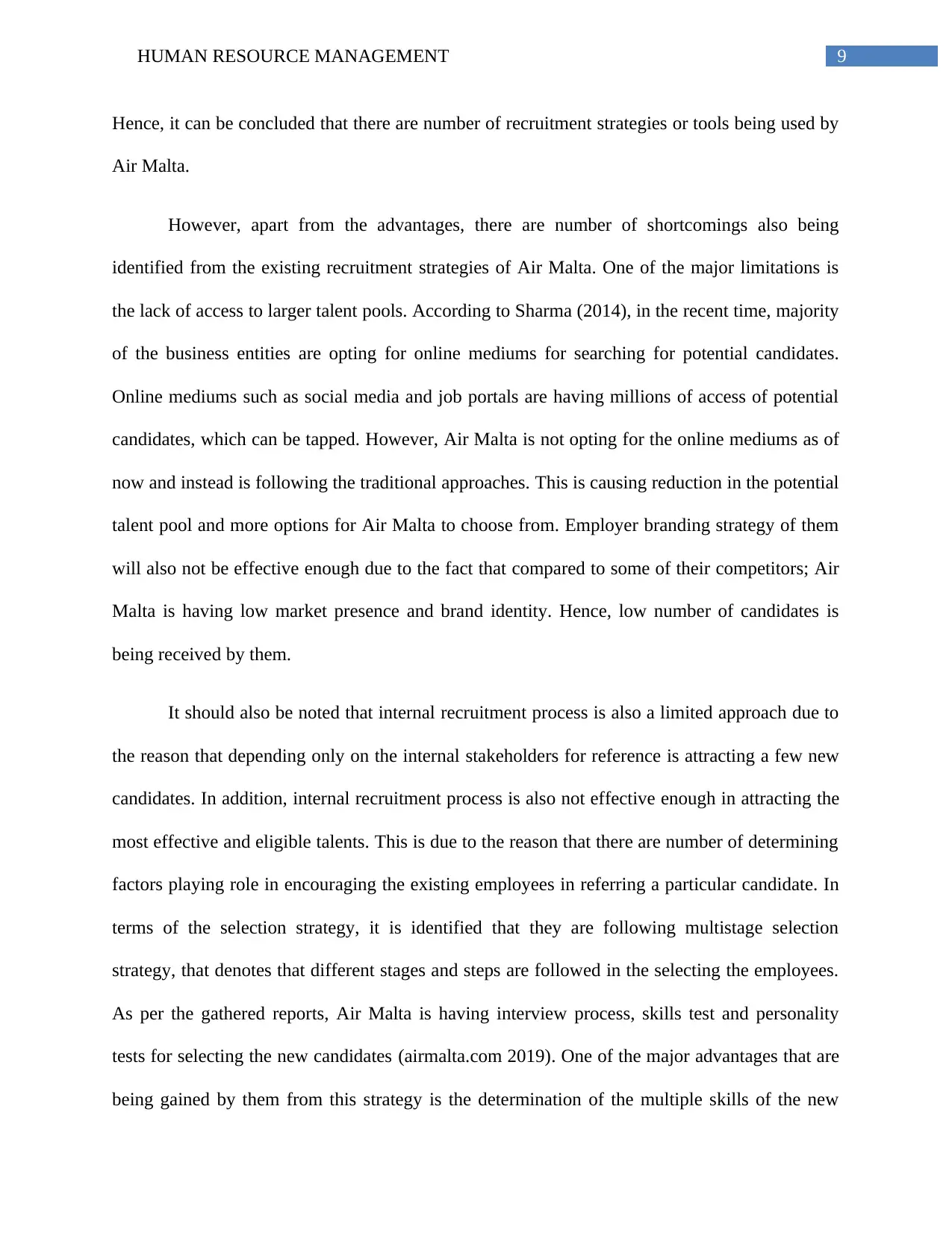
9HUMAN RESOURCE MANAGEMENT
Hence, it can be concluded that there are number of recruitment strategies or tools being used by
Air Malta.
However, apart from the advantages, there are number of shortcomings also being
identified from the existing recruitment strategies of Air Malta. One of the major limitations is
the lack of access to larger talent pools. According to Sharma (2014), in the recent time, majority
of the business entities are opting for online mediums for searching for potential candidates.
Online mediums such as social media and job portals are having millions of access of potential
candidates, which can be tapped. However, Air Malta is not opting for the online mediums as of
now and instead is following the traditional approaches. This is causing reduction in the potential
talent pool and more options for Air Malta to choose from. Employer branding strategy of them
will also not be effective enough due to the fact that compared to some of their competitors; Air
Malta is having low market presence and brand identity. Hence, low number of candidates is
being received by them.
It should also be noted that internal recruitment process is also a limited approach due to
the reason that depending only on the internal stakeholders for reference is attracting a few new
candidates. In addition, internal recruitment process is also not effective enough in attracting the
most effective and eligible talents. This is due to the reason that there are number of determining
factors playing role in encouraging the existing employees in referring a particular candidate. In
terms of the selection strategy, it is identified that they are following multistage selection
strategy, that denotes that different stages and steps are followed in the selecting the employees.
As per the gathered reports, Air Malta is having interview process, skills test and personality
tests for selecting the new candidates (airmalta.com 2019). One of the major advantages that are
being gained by them from this strategy is the determination of the multiple skills of the new
Hence, it can be concluded that there are number of recruitment strategies or tools being used by
Air Malta.
However, apart from the advantages, there are number of shortcomings also being
identified from the existing recruitment strategies of Air Malta. One of the major limitations is
the lack of access to larger talent pools. According to Sharma (2014), in the recent time, majority
of the business entities are opting for online mediums for searching for potential candidates.
Online mediums such as social media and job portals are having millions of access of potential
candidates, which can be tapped. However, Air Malta is not opting for the online mediums as of
now and instead is following the traditional approaches. This is causing reduction in the potential
talent pool and more options for Air Malta to choose from. Employer branding strategy of them
will also not be effective enough due to the fact that compared to some of their competitors; Air
Malta is having low market presence and brand identity. Hence, low number of candidates is
being received by them.
It should also be noted that internal recruitment process is also a limited approach due to
the reason that depending only on the internal stakeholders for reference is attracting a few new
candidates. In addition, internal recruitment process is also not effective enough in attracting the
most effective and eligible talents. This is due to the reason that there are number of determining
factors playing role in encouraging the existing employees in referring a particular candidate. In
terms of the selection strategy, it is identified that they are following multistage selection
strategy, that denotes that different stages and steps are followed in the selecting the employees.
As per the gathered reports, Air Malta is having interview process, skills test and personality
tests for selecting the new candidates (airmalta.com 2019). One of the major advantages that are
being gained by them from this strategy is the determination of the multiple skills of the new
Paraphrase This Document
Need a fresh take? Get an instant paraphrase of this document with our AI Paraphraser
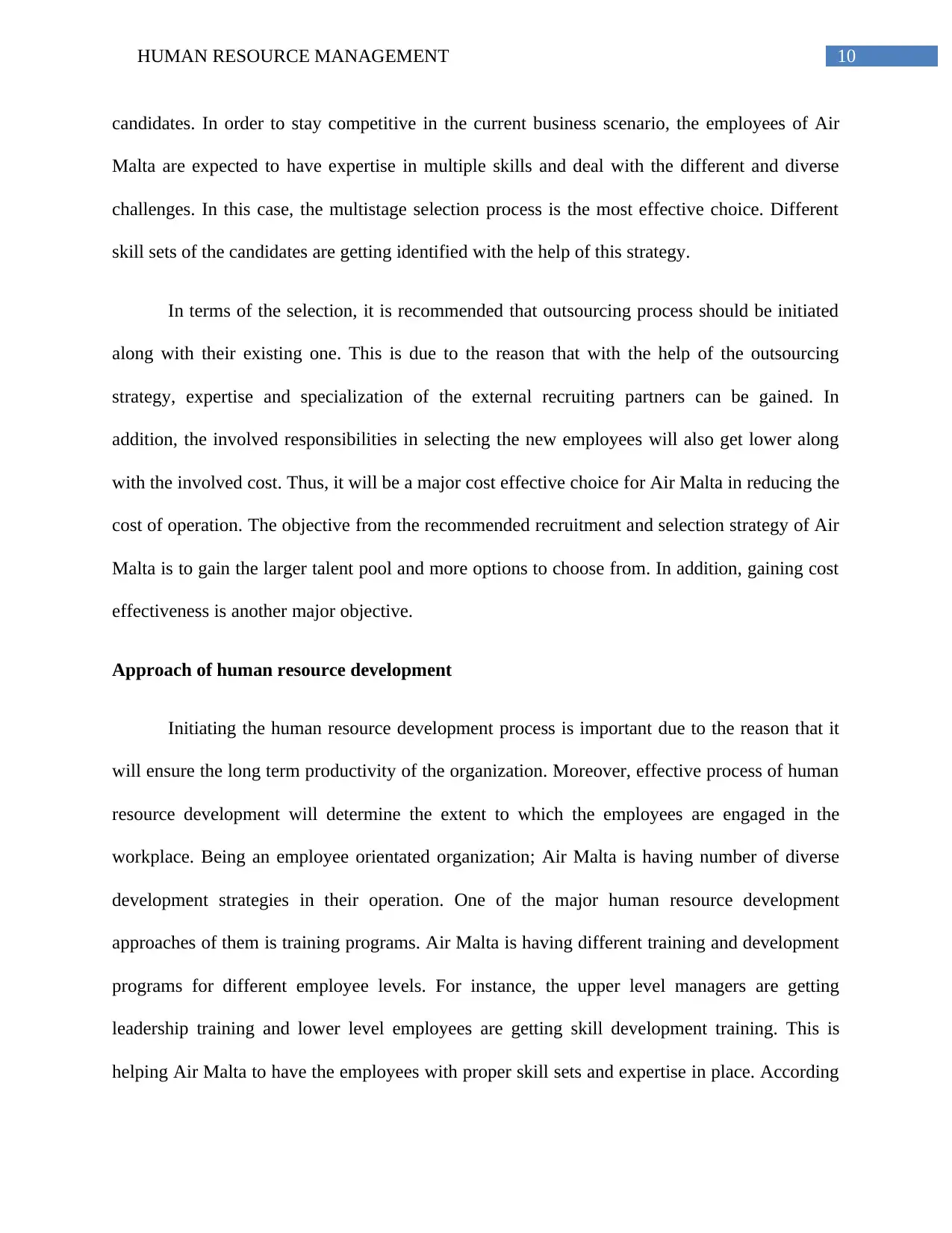
10HUMAN RESOURCE MANAGEMENT
candidates. In order to stay competitive in the current business scenario, the employees of Air
Malta are expected to have expertise in multiple skills and deal with the different and diverse
challenges. In this case, the multistage selection process is the most effective choice. Different
skill sets of the candidates are getting identified with the help of this strategy.
In terms of the selection, it is recommended that outsourcing process should be initiated
along with their existing one. This is due to the reason that with the help of the outsourcing
strategy, expertise and specialization of the external recruiting partners can be gained. In
addition, the involved responsibilities in selecting the new employees will also get lower along
with the involved cost. Thus, it will be a major cost effective choice for Air Malta in reducing the
cost of operation. The objective from the recommended recruitment and selection strategy of Air
Malta is to gain the larger talent pool and more options to choose from. In addition, gaining cost
effectiveness is another major objective.
Approach of human resource development
Initiating the human resource development process is important due to the reason that it
will ensure the long term productivity of the organization. Moreover, effective process of human
resource development will determine the extent to which the employees are engaged in the
workplace. Being an employee orientated organization; Air Malta is having number of diverse
development strategies in their operation. One of the major human resource development
approaches of them is training programs. Air Malta is having different training and development
programs for different employee levels. For instance, the upper level managers are getting
leadership training and lower level employees are getting skill development training. This is
helping Air Malta to have the employees with proper skill sets and expertise in place. According
candidates. In order to stay competitive in the current business scenario, the employees of Air
Malta are expected to have expertise in multiple skills and deal with the different and diverse
challenges. In this case, the multistage selection process is the most effective choice. Different
skill sets of the candidates are getting identified with the help of this strategy.
In terms of the selection, it is recommended that outsourcing process should be initiated
along with their existing one. This is due to the reason that with the help of the outsourcing
strategy, expertise and specialization of the external recruiting partners can be gained. In
addition, the involved responsibilities in selecting the new employees will also get lower along
with the involved cost. Thus, it will be a major cost effective choice for Air Malta in reducing the
cost of operation. The objective from the recommended recruitment and selection strategy of Air
Malta is to gain the larger talent pool and more options to choose from. In addition, gaining cost
effectiveness is another major objective.
Approach of human resource development
Initiating the human resource development process is important due to the reason that it
will ensure the long term productivity of the organization. Moreover, effective process of human
resource development will determine the extent to which the employees are engaged in the
workplace. Being an employee orientated organization; Air Malta is having number of diverse
development strategies in their operation. One of the major human resource development
approaches of them is training programs. Air Malta is having different training and development
programs for different employee levels. For instance, the upper level managers are getting
leadership training and lower level employees are getting skill development training. This is
helping Air Malta to have the employees with proper skill sets and expertise in place. According
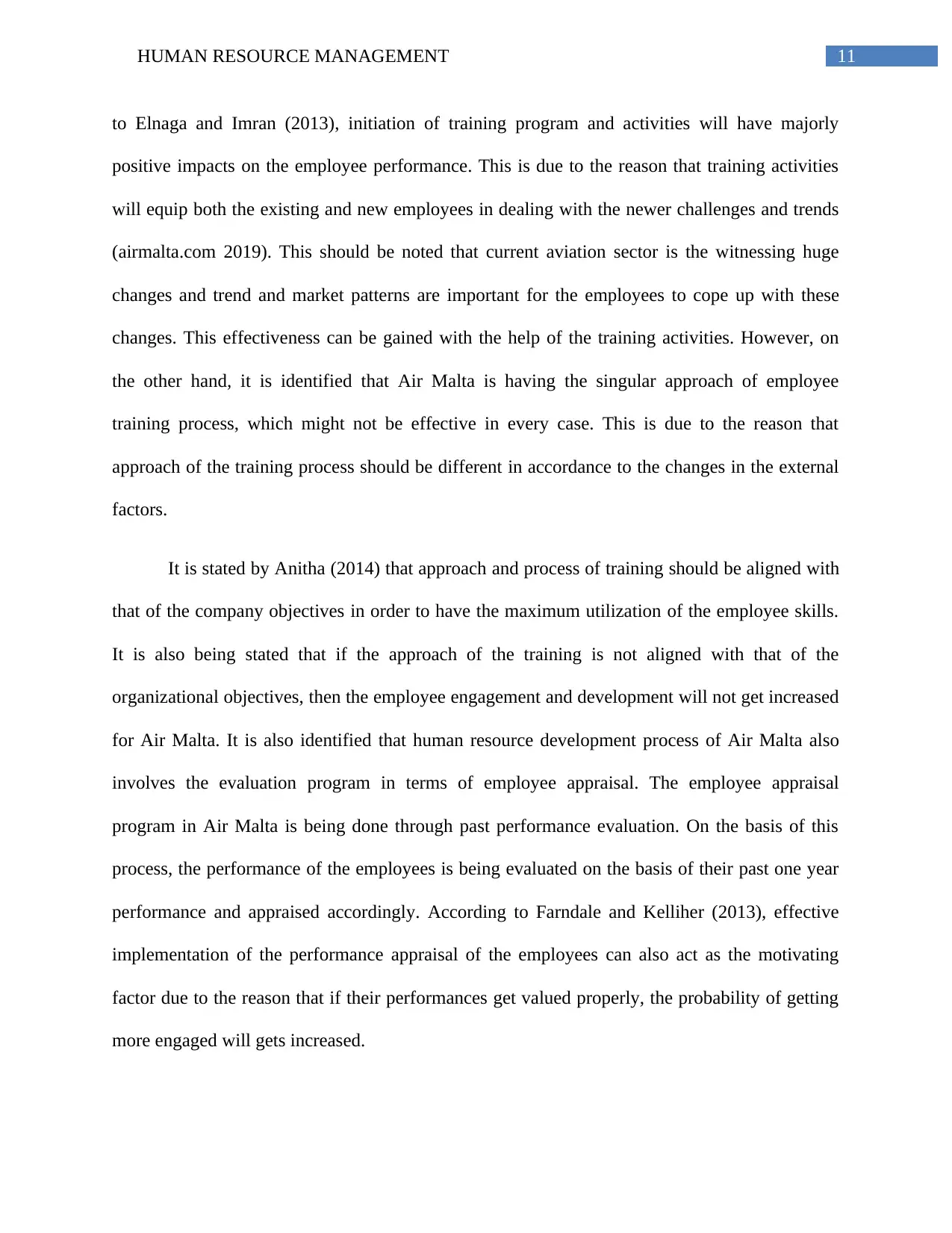
11HUMAN RESOURCE MANAGEMENT
to Elnaga and Imran (2013), initiation of training program and activities will have majorly
positive impacts on the employee performance. This is due to the reason that training activities
will equip both the existing and new employees in dealing with the newer challenges and trends
(airmalta.com 2019). This should be noted that current aviation sector is the witnessing huge
changes and trend and market patterns are important for the employees to cope up with these
changes. This effectiveness can be gained with the help of the training activities. However, on
the other hand, it is identified that Air Malta is having the singular approach of employee
training process, which might not be effective in every case. This is due to the reason that
approach of the training process should be different in accordance to the changes in the external
factors.
It is stated by Anitha (2014) that approach and process of training should be aligned with
that of the company objectives in order to have the maximum utilization of the employee skills.
It is also being stated that if the approach of the training is not aligned with that of the
organizational objectives, then the employee engagement and development will not get increased
for Air Malta. It is also identified that human resource development process of Air Malta also
involves the evaluation program in terms of employee appraisal. The employee appraisal
program in Air Malta is being done through past performance evaluation. On the basis of this
process, the performance of the employees is being evaluated on the basis of their past one year
performance and appraised accordingly. According to Farndale and Kelliher (2013), effective
implementation of the performance appraisal of the employees can also act as the motivating
factor due to the reason that if their performances get valued properly, the probability of getting
more engaged will gets increased.
to Elnaga and Imran (2013), initiation of training program and activities will have majorly
positive impacts on the employee performance. This is due to the reason that training activities
will equip both the existing and new employees in dealing with the newer challenges and trends
(airmalta.com 2019). This should be noted that current aviation sector is the witnessing huge
changes and trend and market patterns are important for the employees to cope up with these
changes. This effectiveness can be gained with the help of the training activities. However, on
the other hand, it is identified that Air Malta is having the singular approach of employee
training process, which might not be effective in every case. This is due to the reason that
approach of the training process should be different in accordance to the changes in the external
factors.
It is stated by Anitha (2014) that approach and process of training should be aligned with
that of the company objectives in order to have the maximum utilization of the employee skills.
It is also being stated that if the approach of the training is not aligned with that of the
organizational objectives, then the employee engagement and development will not get increased
for Air Malta. It is also identified that human resource development process of Air Malta also
involves the evaluation program in terms of employee appraisal. The employee appraisal
program in Air Malta is being done through past performance evaluation. On the basis of this
process, the performance of the employees is being evaluated on the basis of their past one year
performance and appraised accordingly. According to Farndale and Kelliher (2013), effective
implementation of the performance appraisal of the employees can also act as the motivating
factor due to the reason that if their performances get valued properly, the probability of getting
more engaged will gets increased.
⊘ This is a preview!⊘
Do you want full access?
Subscribe today to unlock all pages.

Trusted by 1+ million students worldwide
1 out of 20
Related Documents
Your All-in-One AI-Powered Toolkit for Academic Success.
+13062052269
info@desklib.com
Available 24*7 on WhatsApp / Email
![[object Object]](/_next/static/media/star-bottom.7253800d.svg)
Unlock your academic potential
Copyright © 2020–2025 A2Z Services. All Rights Reserved. Developed and managed by ZUCOL.





